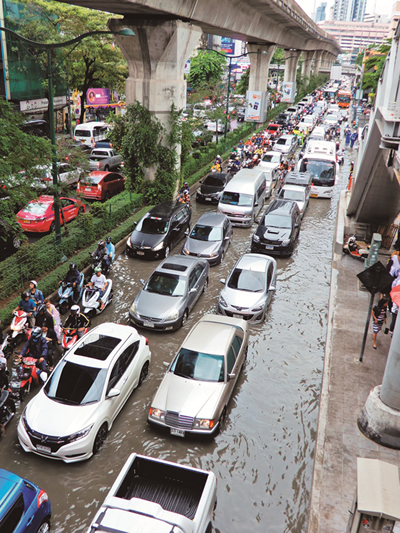The Paris Agreement is the global framework for tackling climate change beyond 2020.
Today, JICA is providing support to accelerate climate actions around the world.
Multi-faceted support for climate actions
In 2015, the 21st Session of the Conference of the Parties (COP21) to the United Nations Framework Convention on Climate Change (UNFCCC) took place in Paris, France, aiming to define an international framework for reducing greenhouse gas emissions and addressing climate change. The Paris Agreement was adopted as a result. The agreement will take effect starting 2020, with a provision for the ambitious long-term goal to keep the global temperature below 2 degrees above pre-industrial levels by the end of the century, and to pursue efforts to limit the temperature increase even further to 1.5 degrees.
JICA is diversifying its efforts to support climate actions in developing countries. Fields of JICA's cooperation include transport, energy, agriculture, disaster risk reduction, as well as forest conservation; and, whenever possible, integrates climate actions into projects in various sectors. For example, in a road improvement project connecting two main islands in an atoll in the Republic of Kiribati in the Pacific, future sea-level rise was taken into account and incorporated into the road design. In a project for developing agriculture in Africa, JICA has established mobile phone services that enable farmers to get advance notice of droughts and heavy rains, so they can take action to prevent crop damage. In 2017, the total amount of such climate-related financing by JICA reached approximately 787 billion yen. The government of Japan has announced its intention to mobilize approximately 1.3 trillion yen worth of funds for public and private projects related to climate change in to developing countries in 2020, while offering access to Japanese knowledge and experience.

We asked JICA Senior Advisor Masato Kawanishi about the actions developing countries are taking to reduce greenhouse gas emissions in accordance with the Paris Agreement. "JICA is supporting a number of developing countries to build policy frameworks to achieve their emission reduction targets. JICA also provides technical cooperation to enable countries to accurately monitor greenhouse gas emissions and absorptions, and compile the data into greenhouse gas inventories [1] , so that they can track progress towards achieving their targets."
Cooperating with cities around the world to combat climate change
Increased attention is given to climate actions at the city level. Primarily because cities, where people and economic activities are concentrated, are responsible for 70% of global greenhouse gas emissions. JICA has signed a memorandum with the C40 Cities Climate Leadership Group (C40), agreeing to cooperate to support climate actions in megacities in Southeast Asia. Projects in this area include Thailand's Bangkok Master Plan on Climate Change, for which JICA is providing design and implementation support (see page 4); development of greenhouse gas inventories, as well as plans to reduce greenhouse emissions in Ho Chi Minh City, Vietnam.
In 2017, JICA became an accredited entity of the Green Climate Fund (GCF), an international fund established based on the UNFCCC to support developing countries gain access to climate finance. This enables JICA to mobilize financial resources other than Japan's official development assistance (ODA). JICA will actively mobilize GCF finance to meet the fast-growing needs of developing countries for climate actions.
National, Municipal, Corporate, Individual-
Action needed at every level!
Kawanishi explains, "The Paris Agreement stipulates that by the second half of the century, we must have a balance between greenhouse gas emissions and absorptions by forests and other measures, to achieve net zero emissions. This would not be possible unless we reconsider our basic way of life." He continues, "We need efforts at every level, from national to municipal, corporate, and individual."
Even if we are able to achieve net zero greenhouse gas emissions in the future, the gases we have already emitted will remain in the atmosphere and continue to cause global warming for a long period of time. The time has already come for each person on Earth to reconsider the fate of our planet and face the issue of climate change head-on.
Note
- [1]A greenhouse gas inventory is a database that tracks how much greenhouse gas is emitted and sequestered in a country every year (Ministry of the Environment).
Masato Kawanishi
JICA Senior Advisor (Global Environment)
Kawanishi has been engaged in climate issues as Senior Advisor to JICA since 2005. From 2010 to 2015, he served as Chief Advisor for the Project of Capacity Development for Climate Change Strategies in Indonesia, where he was also involved in the formulation of the Climate Change Program Loan. He holds a Doctorate in Engineering, and is a Chartered Financial Analyst(CFA).

Two Main Fronts of Climate Actions
Mitigation and adaptation. "Mitigation" means preventing further progress of global warming by reducing, or sequestering, greenhouse gas emission; "adaptation" means minimizing the damage caused by the negative impacts of climate change that are taking place. Some cross-cutting projects address both mitigation and adaptation.

ADAPTATION
Minimizing the negative impacts of climate change
Examples
- Measures against drought (water resource management, irrigation)
- Flood control, early warning systems
- Infection control (against water/insect-borne diseases)
- Improved crops (for heat tolerance)
- Ecosystem/biodiversity conservation

MITIGATION
Reducing greenhouse gas emissions and increasing sequestration
Examples
- Shifting to zero-carbon societies
- Energy efficiency and renewable energy
- Implementing measures towards zero-carbon transport, city and regional planning
- Reducing deforestation
- Solid waste management (controlling methane emissions)




scroll